 By DAVE KIFFER May 06, 2009
Ketchikan, Alaska - The history of Ketchikan can be easily summed up in the history of four industries: Mining, Fishing, Timber and Tourism. Generations of Tlingit Natives used the area around Ketchikan Creek for summer fishing camps, but archeological evidence indicates that only a handful lived in the area year round. In the early 1880s, fishermen from the Lower 48 began to come into the area and a short-lived salmon saltery owned by a gentleman from Oregon named Snow was built near the Creek in 1883. Like many early Ketchikan buildings, it burned down and was not rebuilt. 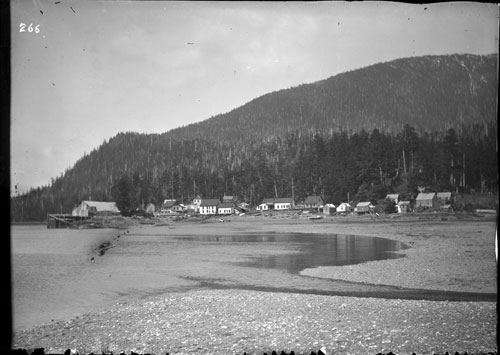 Hunt photo -- Donor: Forest J. Hunt Photograph courtesy Tongass Historical Society 62.4.1.266 In 1885, Mike Martin was sent by an Oregon cannery to take advantage of one of the most abundant fish streams in the region. A rival cannery was operating 25 miles up the coast in the village of Loring, but Martin believed that operations nearer the creek would be more profitable. According to local legend, Martin purchased 160 acres at the mouth of Ketchikan Creek from a Native named Papernose Charlie. Papernose Charlie was actually a Canadian Native, so it's not clear how he was able to "sell" the land that became Ketchikan, but Martin was able to file mining claims on the land and those were upheld later in the court. 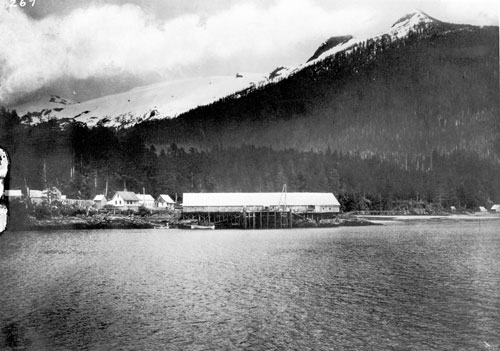 Hunt Photo -- Donor: Forest J. Hunt Photograph courtesy Tongass Historical Society 62.4.3.269 The name Ketchikan itself is also shrouded in mystery. Some say it is an obsolete Tlingit word meaning the "spread wings of a Eagle." Others say is actually means the "land of Kitch" reportedly a long ago Native leader. No one knows for sure. The cannery plan didn't pan out but Martin stayed on and - with partner George Clark - started a saltery and a trading post. Ketchikan remained a small handful of shacks well into the 1890s as Loring grew into a more substantial community. 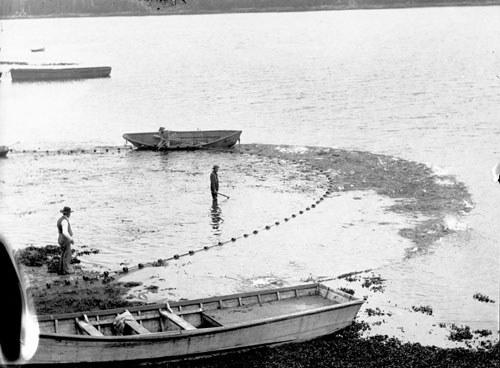 Willis A. Bryant photo -- Donor: Arthur Bryant Photograph courtesy Tongass Historical Society 70.7.5.74 But in the by the mid 1890s, the local mining industry began to take shape. Even before the famed Klondike Gold Rush of 1898, prospectors were already probing the hills around Ketchikan for gold, silver and other minerals. When more than 100,000 gold seekers flooded Alaska and the Yukon in 1898-1899, a sizeable number ended up in the Ketchikan area. By 1900, Ketchikan was the center of the mining operations and nearly 1,000 people lived in the community. A simmering dispute with Loring officials over who would control the Ketchikan area led to the incorporation of Ketchikan as a city. Mike Martin - by now a prosperous saloon owner - was elected the first mayor. 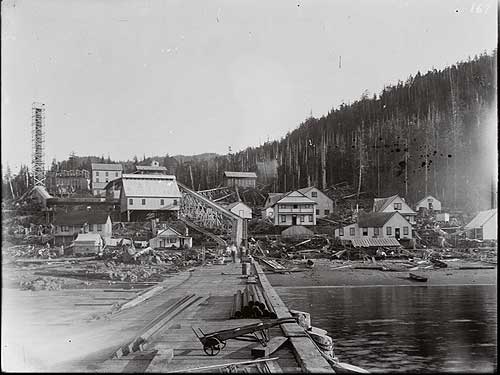 Photographer: Harriet Hunt Donor: Forest J. Hunt, THS 62.4.4.167 Photo courtesy Ketchikan Museums
The fishing industry also began to expand in this period. The first full sized cannery in Ketchikan was built by Fidalgo Island Packing south of the Creek in 1900. 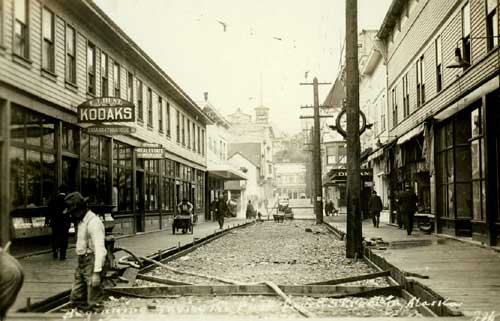 This was the first paved street in Alaska. Note Forest J. Hunt's stationery/photo store on the left. He occupied this space from 1919 to 1942. The word, "KODAKS" on the sign refers to photos, not cameras. Forest J. Hunt photo -- Donor: Bert Libe Estate Photograph courtesy Tongass Historical Society 86.1.42.116
Low mineral prices eventually stalled the mining industry but in the 1920s, the fishing industry took over as the area's economic engine. At its peak in the late 1920s and early 1930s, more than a dozen salmon canneries operated along the Tongass Narrows waterfront. Locals say the "smell" of money was in the air 24 hours a day those summers. Briefly, Ketchikan - with more than 5,000 residents - was the largest city in the state. 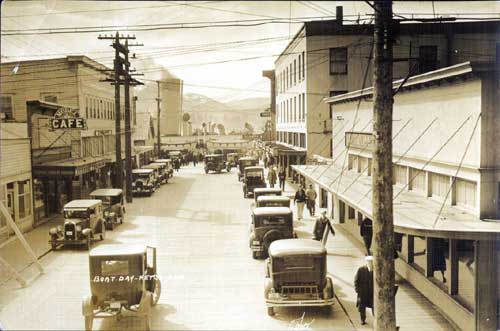 Mission Street looking from looking west from Main Street, circa 1930 Elliot L. Fisher photo ---Donor: Ralph A. Bartholomew Photograph courtesy Tongass Historical Society 72.5.7.2
During this time, Ketchikan also got more than a bit of notoriety out of its "open" nature. Because of its close location to the Canadian border, rum running was easy during Prohibition and Ketchikan's Creek Street Red Light District was infamous up and down the coast as the only place in the world when both "men and fish went up the creek to spawn." 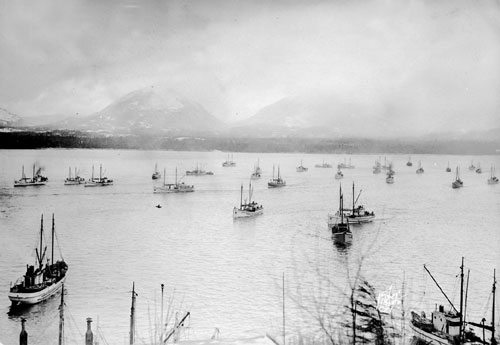 Fisher Studio photo -- Donor: Ed Elliot Photograph courtesy Tongass Historical Society 61.8.1.445
Ketchikan's rapid growth in the 1920s also led to Ketchikan having a large number of historic structures - homes and businesses - from that period. Per capita, Ketchikan has the most historic properties in the state. 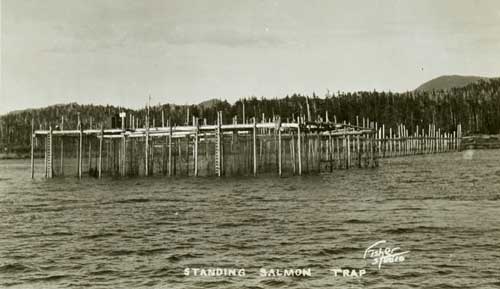 This Sunny Point Cannery Company trap near Ketchikan was typical of standing traps, some-times called pile traps because they "stood" on piling. Photographer: Elliott Fisher -- Donor: Norman A MacDonald Photograph courtesy Tongass Historical Society 96.2.31.5
By the early 1950s, the salmon were nearly gone and only four canneries were operating in the Ketchikan area. Ketchikan had experienced an economic boost during World War II when hundreds of soldiers and sailors were stationed in the community to help bolster Alaskan defenses. A large military airport was also built on nearby Annette Island. But after the war, things settled back into the doldrums as local residents wondered if the fishing industry would ever rebound. 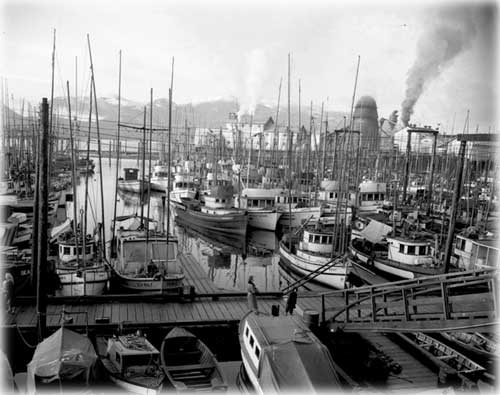 Paulu T. Saari photo -- Donor: Paulu T. Saari Photograph courtesy Ketchikan Museums 2003.2.63.223
Ketchikan Spruce Mill operated for nearly 80 years along Ketchikan's downtown waterfront and several other sawmills operated in the area. But in the late 1940s, the federal government began a concerted effort to open up the National Forest to large scale pulp and paper development. Two large corporations were given 50 year contracts to establish pulp mills in Ketchikan and Sitka. The idea was to boost the economy by provided several hundred well-paying year round jobs. The construction of Ketchikan's pulp mill in 1954, also spurred a major construction boom in the community as roads were widened, subdivisions were built and three, hundred unit, multi-story apartment buildings were constructed. 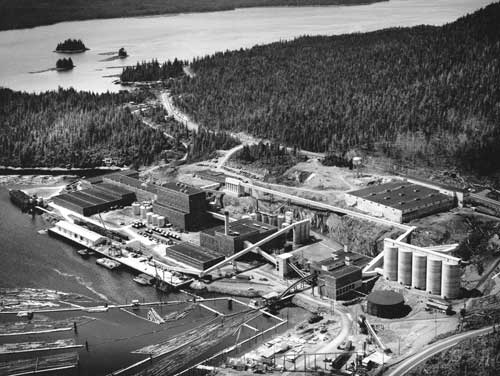 Donor: Ketchikan Pulp Company Photograph courtesy Ketchikan Museums 94.2.17.1 The coming of the pulp mill also signaled a significant shift in Ketchikan's economy. During the heyday of the fishing industry, Ketchikan's economy focused almost entirely on the summer fishing season and residents often lived on credit during the winter. The pulp mill created more than 500 direct and approximately 1,500 other indirect year-round jobs and pumped a hundred million dollars into the local economy each year. The pulp operations also spread to neighboring communities as logging operations moved throughout the national forest. Ketchikan became a supply center for all those communities in Southern Southeast Alaska. In 1959, Alaska became a state and one of the first acts of the new state government was to ban fish traps on state land. In the 1960s, the fishing industry began to recover, although Ketchikan would never again be the true Salmon Capital of the World. The state government also created the Alaska Marine Highway System which soon linked Ketchikan with other communities in Southeast Alaska, as well as Prince Rupert, British Columbia and Seattle, Washington. Ketchikan would not be on the "road system" but regular ferry service was as close as the community could get. 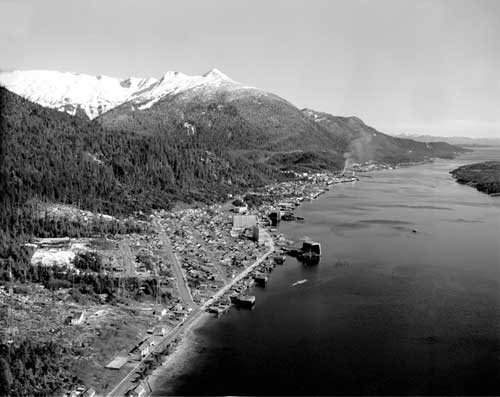 Paulu T. Saari photo Donor: Paulu T. Saari Photograph courtesy Ketchikan Museums 2003.2.63.16
By the mid 1970s, the timber industry began to wane. Ketchikan's pulp mill was becoming outdated and would need major upgrades to meet newer, tougher environmental laws. The rise of the national environmental movement also made it less likely that another long-term contract would be offered under terms acceptable to the timber industry. The mill continued to operate in Ketchikan until 1997, but the industry gradually began to shrink in influence. At the same time, the visitor industry began to grow in importance in the local economy. Alaska had been a "tourist" destination since the 1890s and the steamships that brought the early visitors all stopped in Alaska's "First City" on the way north and south. From the early 1900s, there were curio shops along Ketchikan's waterfront and the first guided fishing and sightseeing tours had started up by the 1930s. Up until the early 1970s, most visitors either came on the Marine Highway or on small Canadian coastal cruise ships like the Prince George or the Princess Patricia a couple of times a week. 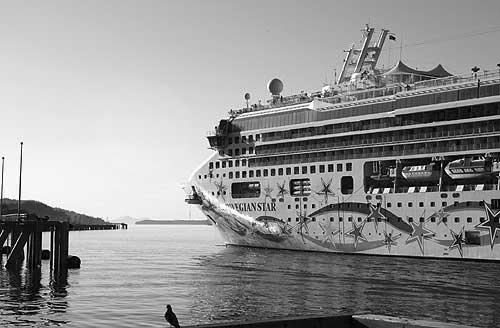 One of the largest and fastest ships in the Norwegian Cruise Line Size of Ship: 91,000 tons -- Passenger Capacity: 2,240 passengers Photograph by Carl Thompson
Many businesses in Ketchikan's downtown area shifted north to Ketchikan's West End and were replaced by seasonal, tourism related businesses downtown. The local economy - and population base - had taken a hit when the pulp mill closed and most timber operations shut down in 1997, but by 2005 the overall economy was back at pre mill closure levels. The population was still down 1,500 from its all-time high of 14,500 in 1996 and the economy had shifted toward seasonal rather than year round, but Ketchikan was still maintaining its status as the regional shopping and service hub for Southern Southeast Alaska.
Dave Kiffer is a freelance writer living in Ketchikan, Alaska. To republish this article, the author requires a publication fee. Contact Dave at dave@sitnews.us Dave Kiffer ©2009
|
|||